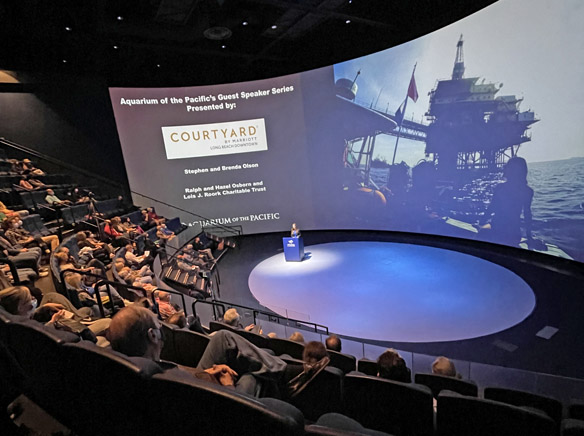It’s time for the people of California to begin thinking about what will become of the 27 offshore oil rigs that now dot the coast from Huntington Beach to Santa Barbara, the Co-President of the Blue Latitudes foundation said Wednesday inside the circular Pacific Visions theater at the Aquarium of the Pacific.
As the community emerges from the pandemic, the Aquarium’s new President Dr. Peter Kareiva said he was “overjoyed” to see the resumption of the “First Wednesday” lecture series presented by the institution.
Kareiva introduced Amber Sparks, co-president of the Blue Latitudes Foundation, who said the foundation’s mission is to “elevate the traditional concept of ocean stewardship by uniting government, industry and the community to work together to conserve our oceans.”
“I want to share with you a story that’s a little different than what you may think you know about the realities of offshore oil and gas development and decommissioning here in California, and how we can reimagine our energy past as our eco-friendly future,” she said.
Sparks, a marine biologist, presented graphic illustrations of the various oil rigs off the state’s coast, indicating which ones were actively pumping oil, which ones have been shuttered and how many of them can be transformed into living reefs for ocean habitat.
“These platforms, from our beaches, look like menacing industrial giants. And they’ve been offshore for decades, extracting offshore oil and gas resources. But as our blue economy shifts from oil and gas to renewable resources, the decommissioning of these platforms is imminent,” said Sparks.
“Oil companies have begun to ask themselves what to do when the oil wells dry up,” said Sparks, “when these resources are no longer economically viable to extract.”
She said the process of shutting down an oil rig is called “decommissioning,” adding that it is “the engineering feat of a lifetime” determining how to remove a structure the size of the Empire State Building from the ocean floor.
Before oil and gas companies are allowed to drill, they must buy bonds sufficient in size to be able fund the rig’s eventually decommissioning process, Sparks told the group.
Former California Governor Arnold Schwarzenegger signed a bill while in office that would allow the state to take over the “jacket” of the well, its super structure, while the liability of the actual capped wells would remain the liability of the oil company as rigs are decommissioned.
But, said Sparks, the state’s conservation coffers could eventually inherit billions as rigs decommission.
“If 23 of California’s 27 platforms were to be decommissioned, there would be a total of a billion dollars in saved costs. She said 65 to 85% of those saved costs would go back to the state. So that’s anywhere between 650 to 850 million to the state into an endowment for marine preservation and conservation. That comes from the oil companies,” said Sparks.
However, because of the legislation’s ambiguity, there has been no effort to fund the measure or set up governmental structures to formally allow for the conversion of the state’s rigs into reefs.
Other places around the world, such as southern states in the Gulf of Mexico, have already established governmental units that work with various authorities to formally convert rigs to reefs with astonishing success.
“Ocean scientists and researchers have studied artificial reefs,” said Sparks,” and have concluded the complex lattice work of undersea oil platforms “create an excellent foundation for these ecosystems to develop.”
“What makes an oil platform such a good candidate,” she said, is the fact that “an artificial reef secret really lies within the structure itself, ranging from sea floor to sea surface, there’s a lot of real estate, nooks and crannies for marine life to colonize and grow.”
“Scientists from UC Santa Barbara have found these platforms are some of the most productive ecosystems on the planet,” said Sparks. “In fact, in some locations, these platforms have the ability to rebound fisheries’ populations.”
She cited the example of a study involving the “impacted” population of rockfish, attempting to the answer the question of “production vs. attraction,” or whether these fish are just “swimming by or are they functioning as a source of production of marine life.”
“You answer this question by going into the gut of the fish. You are what you eat,” said Sparks, “and marine scientists have traced what the fish has eaten back to the platform or natural reef habitat.”
Sparks gave examples of thriving eco-systems from artificial reefs in Africa, Asia and other places around the world. In fact, she cited examples of eco-tourism where the rigs to reefs program has even been transformed into a driver of tourism, where one large rig offers rooms for eco-tourists to stay.
Not every offshore rig is a candidate for reefs, she noted, and there is currently a debate over whether or not the rig must remain a certain height, whether they can be turned onto their side and other environmental factors that must be studied before any reef project can begin.
Building public support for the rigs to reefs program, Sparks said, is essential. She said the state’s decommissioning efforts are in the hands of the State Lands Commission and will soon issue plans for a “Platform Holley,” a bankrupt, decommissioned platform about which they will issue an environmental assessment to determine the best route forward and will be seeking public comments.
“Stay tuned for that,” she urged.
She urged public support for “implementing research in California that could provide a viable alternative to the status quo” as well as creating “a replicable and scalable solution to catalyze some of the sustainable ocean development.”





